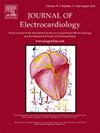Direct mathematical method for real-time ischemic episodes detection from electrocardiograms using the discrete Hermite transform
IF 1.3
4区 医学
Q3 CARDIAC & CARDIOVASCULAR SYSTEMS
引用次数: 0
Abstract
A real-time automated identification technique is developed for the detection of ischemic episodes in long-term electrocardiographic (ECG) signals using mathematical expansions involving the Discrete Dilated Hermite Transform. The Discrete Hermite functions could be viewed as a set of orthogonal vectors that resemble a finite Fourier series. They are generated easily as eigenvectors of a symmetric tridiagonal matrix that commutes with the centered Fourier matrix. The Discrete Hermite Transform (DHmT) values are computed from a simple dot product between an individual ECG complex extracted from the European Society of Cardiology (ESC) ST-T database and the corresponding discrete Hermite function. These values are found to contain information about the ECG shape, highlighting changes between ST segment and T wave alterations which are the features of ischemic episodes. This information from the discrete Hermite transform, based on an orthonormal set of n-dimensional digital Hermite functions that serve as shape-identification functions, can be used to identify ischemic episodes from the ECG. The performance measures resulting from applying this method to detect ischemic episodes were Sensitivity 87 %, Specificity 86 %, and positive predictive accuracy 81 %. The computer time to analyze one heartbeat for ischemia with this method is 0.031 seconds on a standard PC.
利用离散埃尔米特变换从心电图中实时检测缺血发作的直接数学方法
利用离散扩张埃尔米特变换的数学展开,开发了一种实时自动识别技术,用于检测长期心电图(ECG)信号中的缺血性发作。离散埃尔米特函数可以看作是一组正交向量,类似于有限傅里叶级数。它们很容易被生成为对称三对角矩阵的特征向量,与中心傅里叶矩阵交换。离散埃尔米特变换(DHmT)值是从欧洲心脏病学会(ESC) ST-T数据库中提取的单个ECG复合体与相应的离散埃尔米特函数之间的简单点积计算得到的。发现这些值包含有关ECG形状的信息,突出了ST段和T波改变之间的变化,这是缺血性发作的特征。基于一组标准正交的n维数字Hermite函数作为形状识别函数,该信息来自离散Hermite变换,可用于识别ECG中的缺血性发作。应用该方法检测缺血性发作的性能指标灵敏度为87%,特异性为86%,阳性预测准确率为81%。用这种方法分析一次心跳缺血的计算机时间在标准PC上为0.031秒。
本文章由计算机程序翻译,如有差异,请以英文原文为准。
求助全文
约1分钟内获得全文
求助全文
来源期刊

Journal of electrocardiology
医学-心血管系统
CiteScore
2.70
自引率
7.70%
发文量
152
审稿时长
38 days
期刊介绍:
The Journal of Electrocardiology is devoted exclusively to clinical and experimental studies of the electrical activities of the heart. It seeks to contribute significantly to the accuracy of diagnosis and prognosis and the effective treatment, prevention, or delay of heart disease. Editorial contents include electrocardiography, vectorcardiography, arrhythmias, membrane action potential, cardiac pacing, monitoring defibrillation, instrumentation, drug effects, and computer applications.
 求助内容:
求助内容: 应助结果提醒方式:
应助结果提醒方式:


